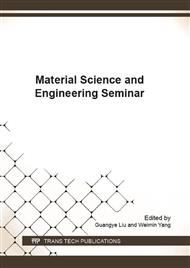[1]
Brinksmeier E, Brockhoff T, Utilization of grinding heat as a new heat treatment process, CIRP Annals-Manufacturing Technology, 45(1): 283-286.
DOI: 10.1016/s0007-8506(07)63064-9
Google Scholar
[2]
Brockhoff T, Brinksmeier E and Grind-hardening: a comprehensive view [J], CIRP Annals-Manufacturing Technology, 1999, 48(1): 255-260.
DOI: 10.1016/s0007-8506(07)63178-3
Google Scholar
[3]
Zarudi I, Zhang L C, Mechanical property improvement of quenchable steel by grinding [J], Journal of Materials Science, 2002, 37(18): 3935-3943.
Google Scholar
[4]
Zhang L, Theory analysis and experimental investigation for single-pass plane grinding-hardening technology, Shandong University doctoral thesis, (2006).
Google Scholar
[5]
Zhang Y, Ge P Q, Zhang L Jingliang Jiang, The Numerical Simulation for Thermal Deformation in Grinding Hardening Thin Workpiece [J], Key Engineering Materials, 2012, 501: 500-504.
DOI: 10.4028/www.scientific.net/kem.501.500
Google Scholar
[6]
Zhang Y, Ge P Q, Zhang L, Numerical Analysis of Surface Temperature in Grind-Hardening Based on Time Variation Heat Flux[C]/Materials Science Forum, 2012, 697: 34-38.
DOI: 10.4028/www.scientific.net/msf.697-698.34
Google Scholar
[7]
Zäh M F, Brinksmeier E, Heinzel C, Experimental and numerical identification of process parameters of grind-hardening and resulting part distortions, Production Engineering, 3(3): 271-279.
DOI: 10.1007/s11740-009-0163-3
Google Scholar
[8]
Kolkwitz B, Foeckerer T, Huntemann J W, Identification and analysis of part distortion resulting from grind-hardening process using computer-based methods, Proceedings of the 3rd international conference on distortion engineering 2011: 499-506.
Google Scholar
[9]
Jiang J L, Ge P Q, Zhang Y, et al, A Mathematical Model of Single Grain Forces in Grinding Process [J], Applied Mechanics and Materials, 2012, 229: 1904-(1907).
DOI: 10.4028/www.scientific.net/amm.229-231.1904
Google Scholar
[10]
Jiang, J. L, Ge, P. Q, 2D/3D ground surface topography modeling considering dressing and wear effects in grinding process[J], International Journal of Machine Tools & Manufacture, 2013, 74: 29-40.
DOI: 10.1016/j.ijmachtools.2013.07.002
Google Scholar


